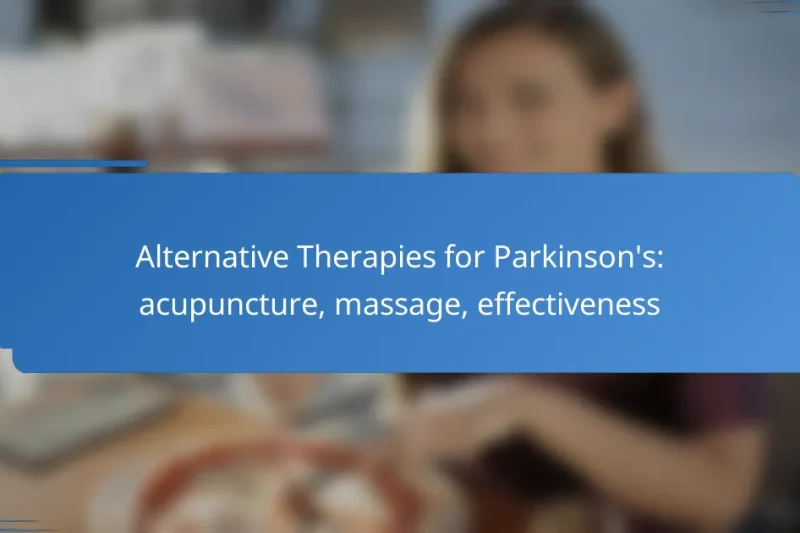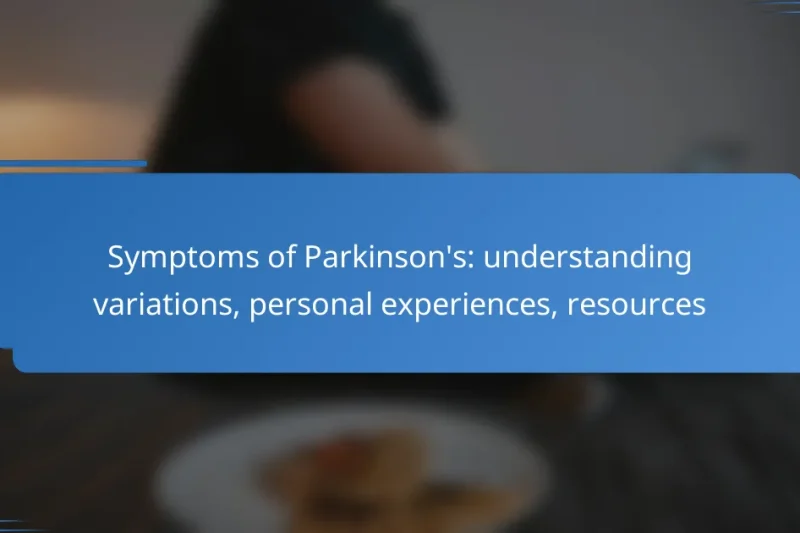Parkinson’s disease is a progressive neurological disorder that typically advances gradually, with symptoms worsening over several … Parkinson’s Disease Progression: timeline, factors influencing speed, care implicationsRead more
Parkinson’s Treatment Options: What You Need to Know
Parkinson’s disease presents unique challenges, but various treatment options are available to help manage its symptoms effectively. In New Zealand, individuals can explore medications, surgical interventions like deep brain stimulation, and supportive therapies to enhance their quality of life. Understanding these options is crucial for making informed decisions about care and treatment.
Alternative Therapies for Parkinson’s: acupuncture, massage, effectiveness
Alternative therapies such as acupuncture and massage are gaining recognition in New Zealand for their potential … Alternative Therapies for Parkinson’s: acupuncture, massage, effectivenessRead more
Symptoms of Parkinson’s: understanding variations, personal experiences, resources
Parkinson’s disease presents a range of symptoms, including tremors, bradykinesia, and muscle stiffness, which can vary … Symptoms of Parkinson’s: understanding variations, personal experiences, resourcesRead more
Complementary Therapies for Parkinson’s: yoga, tai chi, mental health benefits
Complementary therapies such as yoga and tai chi offer valuable benefits for individuals with Parkinson’s disease, … Complementary Therapies for Parkinson’s: yoga, tai chi, mental health benefitsRead more
What are the best treatment options for Parkinson’s in New Zealand?
The best treatment options for Parkinson’s in New Zealand include medications, surgical interventions, and various therapies. Each option aims to manage symptoms effectively and improve the quality of life for individuals living with this condition.
Medications like Levodopa
Levodopa is the most commonly prescribed medication for Parkinson’s, converting into dopamine in the brain to alleviate symptoms. It is often combined with carbidopa to enhance its effectiveness and reduce side effects.
Patients typically start with a low dose, gradually increasing as needed. It’s essential to monitor for potential side effects, such as nausea or dyskinesia, which can occur with long-term use.
Deep brain stimulation
Deep brain stimulation (DBS) involves implanting electrodes in specific brain areas to regulate abnormal signals. This surgical option is considered for patients who do not respond adequately to medications or experience significant side effects.
DBS can significantly improve motor symptoms and reduce medication requirements. However, it requires careful patient selection and ongoing adjustments to the stimulation settings.
Physical therapy
Physical therapy focuses on improving mobility, balance, and strength in individuals with Parkinson’s. Tailored exercise programs can help maintain physical function and reduce the risk of falls.
Therapists may incorporate techniques such as stretching, resistance training, and gait training. Regular sessions can lead to noticeable improvements in daily activities and overall well-being.
Occupational therapy
Occupational therapy assists individuals in adapting their daily activities to manage symptoms effectively. Therapists work with patients to develop strategies that enhance independence in tasks like dressing, cooking, and personal care.
Adaptive tools and techniques are often introduced to simplify tasks and reduce frustration. This personalized approach can significantly enhance quality of life.
Speech therapy
Speech therapy addresses communication challenges and swallowing difficulties that may arise with Parkinson’s. Speech-language pathologists help patients improve their voice volume, clarity, and articulation.
Therapists may use exercises and techniques to strengthen the muscles involved in speech and swallowing. Early intervention can lead to better outcomes and maintain effective communication skills.
How effective are medications for Parkinson’s?
Medications for Parkinson’s can be highly effective in managing symptoms, particularly in the early stages of the disease. The primary goal is to enhance the quality of life by alleviating motor symptoms such as tremors, stiffness, and bradykinesia.
Levodopa is highly effective
Levodopa is the most commonly prescribed medication for Parkinson’s and is known for its significant effectiveness in reducing symptoms. It works by converting into dopamine in the brain, compensating for the decreased levels caused by the disease. Many patients experience substantial improvement within 30 to 60 minutes of taking the medication.
Typically, levodopa is combined with carbidopa to prevent premature conversion to dopamine outside the brain, which helps to enhance its efficacy and reduce side effects. Dosages can vary widely, often starting at low levels and gradually increasing based on individual response and tolerance.
Side effects include dyskinesia
While medications like levodopa are effective, they can also lead to side effects, the most common of which is dyskinesia. This condition manifests as involuntary movements and can occur after prolonged use of levodopa, particularly in later stages of treatment.
To manage dyskinesia, healthcare providers may adjust medication dosages or introduce additional medications to help control these movements. Patients should communicate any new or worsening symptoms to their healthcare team to find the most suitable treatment plan.
What is deep brain stimulation?
Deep brain stimulation (DBS) is a surgical treatment for Parkinson’s disease that involves implanting electrodes in specific brain areas. These electrodes deliver electrical impulses to help regulate abnormal brain activity, alleviating symptoms such as tremors and stiffness.
Minimally invasive surgical procedure
Deep brain stimulation is considered a minimally invasive surgical procedure, meaning it typically requires only small incisions and does not involve major brain surgery. The procedure usually takes a few hours and patients often go home the same day or the next day.
During the surgery, a neurosurgeon places electrodes in targeted brain regions while the patient is awake, allowing for real-time feedback on the effects of stimulation. This precision helps optimize the placement of the electrodes for maximum benefit.
Targets specific brain areas
DBS targets specific areas of the brain, such as the subthalamic nucleus or the globus pallidus internus, which are involved in motor control. By stimulating these regions, DBS can significantly reduce motor symptoms associated with Parkinson’s disease.
Choosing the right target is crucial, as different areas can affect various symptoms. For example, stimulation of the subthalamic nucleus may improve overall motor function, while targeting the globus pallidus internus can help reduce dyskinesias.
What lifestyle changes can help manage Parkinson’s?
Lifestyle changes can significantly aid in managing Parkinson’s symptoms. Regular exercise and a healthy diet are two key areas that can enhance mobility and overall well-being.
Regular exercise improves mobility
Engaging in regular physical activity can help maintain and improve mobility for individuals with Parkinson’s. Activities like walking, swimming, or tai chi can enhance balance, flexibility, and strength.
It is generally recommended to aim for at least 150 minutes of moderate exercise each week. This can be broken down into manageable sessions, such as 30 minutes a day, five days a week.
Consider incorporating exercises that focus on coordination and stability, as these can help reduce the risk of falls. Always consult with a healthcare provider before starting a new exercise program to ensure it is safe and appropriate.
Healthy diet supports overall health
A balanced diet plays a crucial role in supporting overall health for those with Parkinson’s. Emphasizing fruits, vegetables, whole grains, lean proteins, and healthy fats can provide essential nutrients and energy.
Some studies suggest that diets rich in antioxidants, such as the Mediterranean diet, may be beneficial. This diet includes foods like olive oil, fish, nuts, and a variety of colorful fruits and vegetables.
Staying hydrated is also important, as dehydration can exacerbate symptoms. Aim for at least 8 cups (about 2 liters) of fluids daily, adjusting based on activity level and climate. Avoid excessive caffeine and alcohol, as they can interfere with medication and hydration.
What are the costs associated with Parkinson’s treatments in New Zealand?
The costs for Parkinson’s treatments in New Zealand can vary significantly based on the type of treatment and individual patient needs. Patients should expect to budget for both medication and potential surgical options, with costs influenced by factors such as prescription type and healthcare provider fees.
Medication costs vary by prescription
Medication expenses for Parkinson’s disease can range from moderate to high, depending on the specific drugs prescribed. Common medications, such as levodopa, may cost around NZD 20 to NZD 50 per month, while newer treatments could be significantly more expensive.
Patients should consider the availability of subsidized medications through Pharmac, New Zealand’s drug purchasing agency, which can help reduce out-of-pocket costs. It’s advisable to consult with healthcare providers about the most cost-effective options available.
Surgical costs for deep brain stimulation
Deep brain stimulation (DBS) surgery is a more intensive treatment option for Parkinson’s disease, with costs typically ranging from NZD 30,000 to NZD 50,000. This price includes pre-operative assessments, the surgery itself, and post-operative care.
Patients should check with their health insurance providers to understand coverage options for DBS, as some plans may cover a portion of the costs. Additionally, discussing financial assistance programs with healthcare facilities can provide further support for managing these expenses.
What support resources are available for Parkinson’s patients?
Parkinson’s patients can access various support resources that provide assistance, information, and community connections. These resources include national organizations, local support groups, and community services tailored to the needs of individuals living with Parkinson’s disease.
Parkinson’s New Zealand organization
Parkinson’s New Zealand is a key resource for individuals affected by Parkinson’s disease in the country. The organization offers information, advocacy, and support services, helping patients and their families navigate the challenges of the condition.
They provide educational materials, organize events, and connect patients with local support networks. Access to their resources can empower patients to manage their symptoms more effectively and enhance their quality of life.
Support groups and community resources
Support groups play a vital role in providing emotional and practical support for Parkinson’s patients. These groups allow individuals to share experiences, learn from one another, and gain insights into managing their condition.
Community resources may include local health services, rehabilitation programs, and wellness activities designed specifically for those with Parkinson’s. Engaging with these resources can foster a sense of belonging and reduce feelings of isolation.



